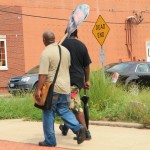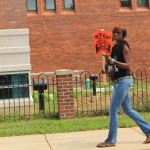The trip to Ferguson made me deeply confront and reflect on my own role in creating and supporting others to create a more equal, just and loving world.
That confrontation began before the trip even began…
TO GO, OR NOT TO GO?
That was the question.
I’d read requests from organizers of the “Black Lives Matter” to allow the ride to Ferguson to be a mainly black-occupied space. They also said they didn’t need more people in Ferguson and encouraged folks from out of town to stay home and organize in their own places. I believe strongly in avoiding “white savior” and helping that is actually harmful, and conversely, in honoring how someone requests to be helped rather than imposing our own idea of what a person or place needs.
But after talking and thinking it over, we decided to go, reasoning that the acts of bringing food, documenting, and simply coming to understand this important and volatile issue (which is not isolated to Ferguson) could be valuable contributions to the effort and, perhaps more importantly, could help us understand the bigger picture and how to be agents of progress.
Also, the voyage wasn’t something we’d just decided to do but rather an opportunity had literally fallen in my lap through the connective powers of friends and, yes, Facebook’s handy friend-connecting interface.
I’ll confess: I was oblivious to the shooting and aftermath for about a week until, after the 30th post from friends crossed my vision via Facebook (yes, I’m horrible about keeping up on the news via normal routes!), I decided to get a grip on what had happened. It seemed to have many dimensions–so I put out a request to friends for links they felt offered good, semi-objective coverage and analysis of the situation.
Among the responses to my plea for perspective was one from Eric Sarver, a community connector I know from Broadway’s neighborhood, made me smile: “You know April, you’re the kind of person I think of as going down there to see for yourself.” His words didn’t go much further in my thinking than an initial good feeling until my friend Lynn (also met via Broadway) wrote to connect me with her friend Ellen, who she studies with at Christian Theological Seminary and who was looking for folks to go with her to Ferguson. When I called Ellen to follow up, I felt a strong heart and mind on the other line. She shared with me that, with a background in law, she trying to learn how to use that background to further social justice and equity, and hopes to offer her skills in some way to what’s happening in Ferguson and/or locally.
Still not 100% sure about “What was right,” I decided to take the plunge and do it. My life and the environment all seemed to be urging toward “yes”… and, on some wider plane, I yearned for the kind of cross-racial alliance like we witnessed in the Civil Rights era, fostered by places like Highlander Institute and non-black activists Grace Lee Boggs.

Ellen (our instigator/driver), Eric Sarver and my fiance, Trae starting the trip with a prayer in the Broadway Church parking lot before we hit the road to Ferguson.
So, early on Saturday morning, Trae and I loaded up the 40 sandwiches we’d made the night before (PB&J and turkey), two cases of bottled water and school supplies donated by our friend Elle Roberts, and headed over to the Broadway parking lot to meet Ellen and, wonderfully, Eric (the friend who’d encouraged me to go down myself!). Ellen led us in a prayer by Martin Luther King from the book, “Thou, Dear God” Prayers the Open Hearts and Spirits, and we were on our way.
ARRIVAL
Our drive from Indianapolis was packed with rich, compelling conversation that wandered from religion to the details of the Michael Brown shooting to community building. We also passed under a bizarre reminder of home — cables fanning down across a bridge over the Mississippi River looked like a winterized version of St. Pete, FL’s bright yellow “Sunshine Skyway Bridge” I’ve driven many times.
Our friend Elle — a local activist and community-builder in Indianapolis whose outspokenness on all matters of equality inspires me endlessly — had pointed us to the location in Ferguson where we would most likely find some organizing going on. Knowing that the previous marches had turned to war zones with militarized police and alleged violent reactions from protesters, as well as the fact that a national ride to Ferguson had been organized for this very weekend, we had NO idea what to expect when we arrived.
As it turned out, we needed very little help from the GPS as we soon spotted people on foot carrying large, brightly colored signs. They were all walking in the same direction in the blazing sun.
After passing what appeared to be the center of action, we doubled around, parked, and hit the street.
A crowd had been collecting outside what we soon learned was the police station where Officer Darren Wilson had been stationed when he shot Michael Brown weeks ago. We saw more signs, both pre-printed and hand-made, with calls for justice, equal treatment of black people by police, and an end to harrassment/racial profiling. There were also messages of grief and loss about Michael Brown.
I have been to a number of demonstrations in my day–in D.C. against the war, in Italy against anti-immigration laws, in FL for farmworker wage-raises. I haven’t felt as much of an outsider, nor as emotionally compelled, as I did upon entering this scene. It probably had something to do with the fact that I was in the racial minority… but also, and more, I think, with the air that was electric — visually, verbally, in peoples’ eyes and gestures — with a sadness, an anger and a frustration springing from experiences I did not have as a white person living in this country. Also, given the national ride organizers’ request for it to be a majority-black space, I was not sure if I and my two other white travel companions were welcomed.
Who am I to be here?
Is my presence dampening the power of this gathering?
Who might people think I am–especially when I’m taking photos or asking questions?
I coped by reminding myself that these worries and fears were pretty shallow and insignificant compared to the worries, fears, and actual experiences of un-welcome that the people of color demonstrating here (and demonstrating about) endure every day. I also reminded myself that, in moving through most “mainstream” spaces in this country, and even in media, I usually enjoy the privilege of not being distinctly aware of my skin color. I told myself to suck it up and stay focused on the original impulse–to be open, present, and supportive–that brought us all down down here to begin with.
So after walking around the scene, snapping photos, Trae and I decided to begin getting past the signs and chants and hear some perspectives…
PERSPECTIVES
1. The Lost Voices / G.I.B.A.M.
This, too, felt daunting–mainly for the reasons listed above. So I started with someone most like me… a young man and woman around my age. As I’d been hoping to hear perspectives of actual Ferguson residents, I was very happy to learn that the young woman, and the spokesperson for her group she then introduced me to, were both from here–and, not just from here, but core members of “The Lost Voices,” a group which has apparently been active and present–even sleeping outside near this site–since Day 1.
The young man who I first spoke with, an out-of-towner, was here in support of this group and part of a grassroots network called “GIBAM.” (I had some camera malfunctions so unfortunately missed the beginning of what he told me.)
Here’s our conversation:
2. Jordan
We headed over to see the “front lines,” where police had formed a row along the lines of the parking lot, with police tape lined between themselves and the crowd. The anger was perhaps most palpable here, as demonstrators both white and black expressed their frustrations with body language — kneeling on the pavement with hands in the air — and words.
I caught eyes with a young man, about 13 or 14, and started up a conversation. It struck me with the strange kind of balance (or tension) he expressed between hopefulness and commitment, and hopelessness for real change:
To Be Continued…














Ah, flower you’ve found a new place to flourish.
I hope that many will read this blog and not just take it as a sensationalized story about Ferguson, racism, community building etc., but read it as an honest experience by a person trying to experience life and unravel its twisted messages. There is hope in this time of darkness. People just have to go and look for it.
from the living Mike Brown.